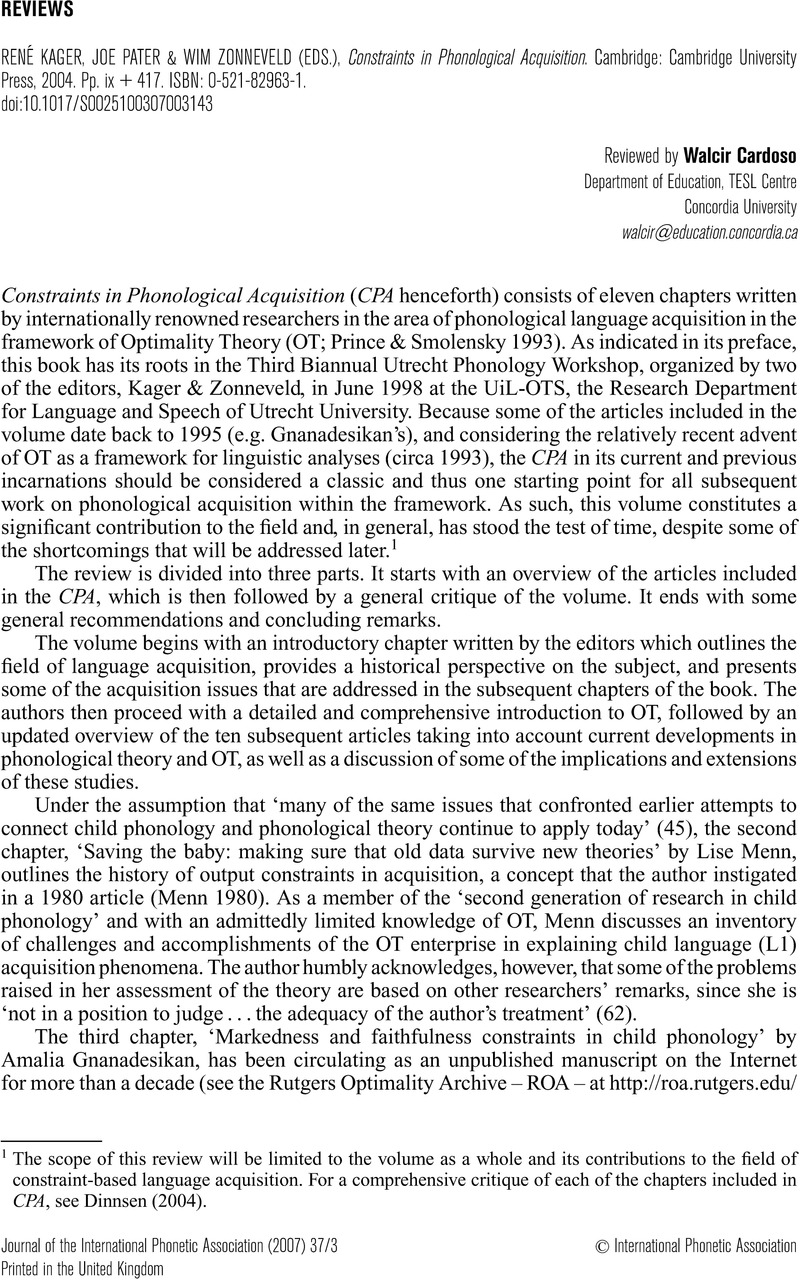No CrossRef data available.
Article contents
RENÉ KAGER, JOE PATER & WIM ZONNEVELD (EDS.), Constraints in Phonological Acquisition. Cambridge: Cambridge University Press, 2004. Pp. ix + 417. ISBN: 0-521-82963-1.
Review products
RENÉ KAGER, JOE PATER & WIM ZONNEVELD (EDS.), Constraints in Phonological Acquisition. Cambridge: Cambridge University Press, 2004. Pp. ix + 417. ISBN: 0-521-82963-1.
Published online by Cambridge University Press: 04 December 2007
Abstract
An abstract is not available for this content so a preview has been provided. Please use the Get access link above for information on how to access this content.

- Type
- Book Review
- Information
- Journal of the International Phonetic Association , Volume 37 , Issue 3 , December 2007 , pp. 329 - 333
- Copyright
- Copyright © Journal of the International Phonetic Association 2007
References
Alderete, J. (2001). Faithfulness to prosodic heads. In McCarthy, J. (ed.), Optimality Theory in Phonology: Selected Readings, 215–227. Oxford: Blackwell.Google Scholar
Bley-Vroman, R. W., Felix, S. & Ioup, G. (1988). The accessibility of Universal Grammar in adult language learning. Second Language Research 4 (1), 1–32.Google Scholar
Blevins, J. (1995). The syllable in phonological theory. In Godsmith, J. (ed.), The Handbook of Phonological Theory, 206–244. Oxford: Blackwell.Google Scholar
Boersma, P. & Hayes, B. (2001). Empirical tests of the Gradual Learning Algorithm. Linguistic Inquiry 32, 45–86.CrossRefGoogle Scholar
Cook, V. J. (1994). UG and the metaphor of access. In Ellis, N. (ed.), Implicit Learning of Language, 477–502. New York: Academic Press.Google Scholar
Dinnsen, D. (2004). Review of Kager, Pater & Zonneveld (ed.), Constraints in Phonological Acquisition. Phonology 21 (3), 431–440.Google Scholar
Menn, L. (1980). Phonological theory and child phonology. In Yeni-Komshian, G. H., Kavanagn, J. F. & Ferguson, C. A. (eds.), Child Phonology, vol. 1: Production, 23–42. New York: Academic Press.CrossRefGoogle Scholar
Prince, A. & Smolensky, P. (1993). Optimality Theory: Constraint Interaction in Generative Grammar. Cambridge, MA: MIT Press.Google Scholar
Smolensky, P. (1996). The Initial State and ‘Richness of the Base’ in Optimality Theory. Technical Report JHU-CogSci-96-4, Cognitive Science Department, Johns Hopkins University. [Rutgers Optimality Archive: 154.]Google Scholar
Tesar, B. & Smolensky, P. (1993). The Learnability of Optimality Theory: An Algorithm and Some Basic Complexity Results. [Rutgers Optimality Archive: 2-1093.]Google Scholar
White, L. (1989). Universal Grammar and Second Language Acquisition. Amsterdam: John Benjamins.CrossRefGoogle Scholar
White, L. (1998). Universal Grammar in second language acquisition: the nature of interlanguage representation. In Eubank, L. (ed.), UG Access in L2 Acquisition: Reassessing the Question, 1–13. Honolulu: University of Hawaii, Second Language Teaching & Curriculum Center.Google Scholar


